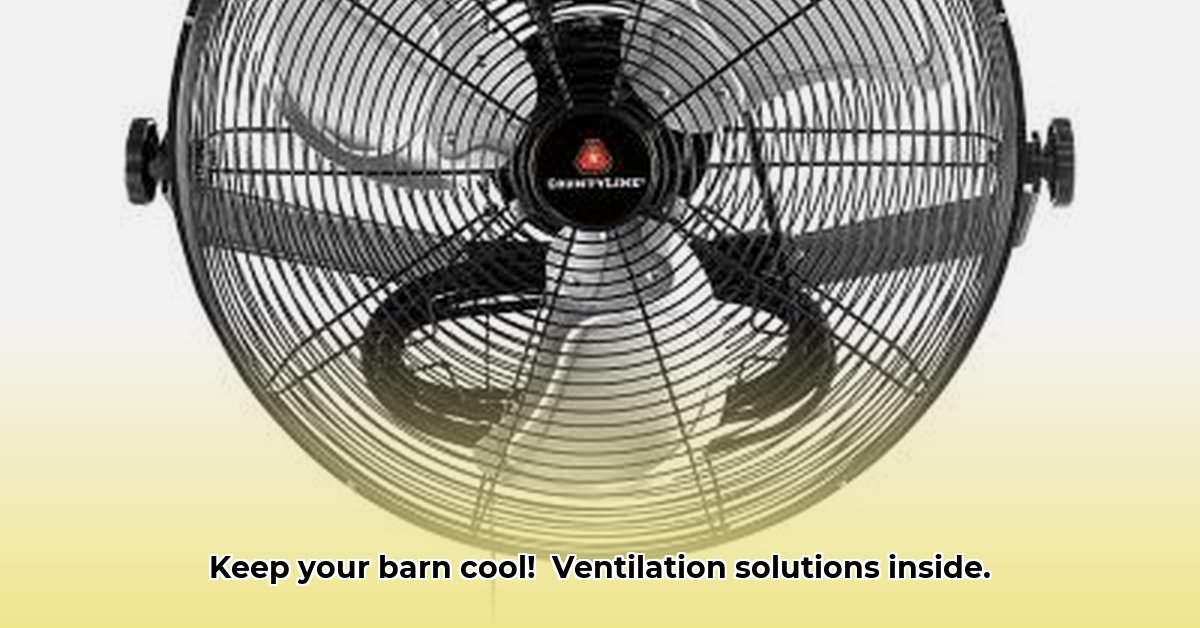
Keeping your barn well-ventilated is crucial for the health and comfort of your livestock and the longevity of your equipment. Tractor Supply offers a wide selection of barn fans, but choosing the right one can be overwhelming. This buyer's guide simplifies the process, helping you select the perfect fan for your specific needs and budget. For added barn storage solutions, check out Tractor Supply sheds.
Understanding Your Barn's Ventilation Needs
Before choosing a fan, assess your barn's requirements. Factors to consider include:
Barn Size and Volume: Larger barns require more powerful fans to ensure adequate airflow. Measuring your barn's dimensions will help determine the necessary cubic feet per minute (CFM) – a crucial metric indicating the volume of air moved per minute. Insufficient CFM can lead to poor air quality and discomfort.
Livestock Type and Density: The number and type of animals significantly impact ventilation needs. Densely packed animals generate more heat and moisture, demanding stronger exhaust fans to prevent the buildup of ammonia and other harmful gases. More animals mean a higher CFM requirement.
Climate: Hot, humid climates necessitate high-volume exhaust fans to remove excess moisture and prevent mold growth. Colder climates require fans that circulate air without creating drafts, which can be achieved through strategic placement and fan type selection. Understanding your local climate conditions plays a vital role in choosing the right fan.
Budget: Barn fans range in price, from budget-friendly models to more expensive, high-performance units. Establishing a budget beforehand helps narrow your options and prevents overspending. However, remember that investing in a durable, efficient fan can save you money on energy costs in the long run—energy efficiency is a key factor.
Types of Barn Fans at Tractor Supply
Tractor Supply offers various fan types, each suited for different applications:
Ceiling Fans: These provide general air circulation, ideal for smaller barns or creating a gentle breeze. They are often the most cost-effective option for smaller spaces. However, their airflow is less targeted than other types.
Wall-Mounted Fans: Designed for targeted airflow, these are perfect for directing air to specific areas, such as individual stalls or feeding troughs. They are easily positioned to minimize drafts while maximizing targeted cooling. Careful placement is key to their effectiveness.
Exhaust Fans: These high-powered fans remove stale, humid air, preventing the buildup of moisture and harmful gases. Critical for maintaining air quality and preventing harmful conditions. Exhaust fans are essential for larger barns or those prone to excessive humidity.
High-Volume, Low-Speed (HVLS) Fans: These industrial-grade fans move massive amounts of air with lower energy consumption than smaller fans, making them ideal for very large barns. Though expensive upfront, they are known for substantial long-term energy savings.
Key Features to Consider
Beyond fan type, several key features influence performance and value:
CFM (Cubic Feet per Minute): This indicates the volume of air moved per minute. Higher CFM values are needed for larger barns and higher animal densities. Calculate your CFM needs based on barn size and livestock.
Horsepower (HP): Specifies the motor's power. Higher horsepower generally means more airflow, but also higher energy consumption. Balance power needs with energy efficiency goals. A balance between CFM and HP is essential for maximizing effectiveness while minimizing costs.
Blade Size and Material: Larger blades typically move more air. Durable materials (steel, reinforced plastic) resist damage and extend fan lifespan. Material selection is crucial for durability in a barn environment.
Noise Level (dB): Excessive noise can stress animals. Opt for fans with lower decibel ratings to maintain a calm barn environment. Consider the proximity to animals when making this decision. Low noise also improves human comfort, particularly if the barn is used for storage, tasks or other activities.
Safety Features: Look for enclosed motors and sturdy construction to minimize potential risks. Safety should always be a primary consideration.
Warranty: A comprehensive warranty protects your investment against defects. A strong warranty provides peace of mind.
Price Range and Feature Comparison
Fan prices vary widely based on size, type, and features. Smaller ceiling fans typically cost less than larger, more powerful exhaust or HVLS fans.
(Note: A detailed price comparison table cannot be provided without access to Tractor Supply's real-time product data.) Use the Tractor Supply website or visit a local store for current pricing and availability.
Installation and Maintenance
Proper installation is crucial. Consult the manufacturer's instructions or seek professional help for complex installations. Regular maintenance, such as cleaning blades and lubricating motor bearings, extends the fan's lifespan and efficiency. Proper maintenance reduces downtime and optimizes performance over time.
Conclusion: Choosing the Right Fan
Selecting the ideal barn fan involves considering your barn's specific needs, your budget, and your priorities. Weigh the pros and cons of each fan type and feature to find the optimal balance. Don't hesitate to consult with experts at your local Tractor Supply store for personalized advice. Proper barn ventilation is vital for animal health, productivity, and your own peace of mind. Remember to check the Tractor Supply website or your local store for the latest models, prices, and availability. Investing in high quality, energy-efficient ventilation solutions will pay off in the long run.